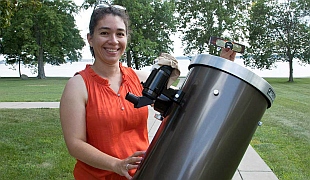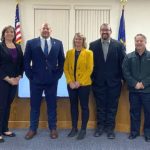The Culver Union Township Public Library will be hosting two talks by Angela Osterman Meyer, Ph.D., covering the solar eclipse on Monday, Aug. 21.
Meyer, the astronomy instructor at Culver Academies, will speak at 10:30 a.m. and again at noon this Saturday. The library staff will also be distributing solar eclipse glasses at these times.
The moon will pass in front of the sun as it crosses from the northwest to the southeast across North America. The event will run from approximately 1 to 3:45 p.m. on Monday, with Culver experiencing 87 percent totality regarding darkness at 2:22 p.m.
“There will be a noticeable change, even if it is cloudy,” Meyer said.
She warns people should not be staring into the sky – especially at the sun – trying to see the eclipse. Even conventional sun glasses do not offer enough protection. Along with the solar glasses being distributed at the library, people can also make pinhole cameras and even use Ritz crackers held in front of a white postcard to watch the image of the eclipse.
It will also be televised live on NASA.gov/eclipse website. Along with the observing the event, NASA and the science site GLOBE Observer are asking citizens to participate in “citizen science” experiments and submit their findings. The data the agencies are seeking includes the change in temperature during the duration of the eclipse, she said. The temperature variation will depend on the humidity. If Monday is humid, the temperature will not drop as much as it will if it dry. But there should be a measurable drop in either case, Meyer explained.
And, for those people who miss the eclipse Monday, Meyer said they really won’t have to wait that long (scientifically speaking) for the next one. The next total solar eclipse crossing North America will be on April 8, 2024, and it will reach 100 percent totality in the Indianapolis metropolitan area. Culver is predicted to reach 98 percent totality.
https://www.globe.gov/web/eclipse/overview
Photo: Angela is standing next to one of the Academies’ 10-inch telescopes and holding a pair of solar glasses that will be used by students to watch the eclipse.















